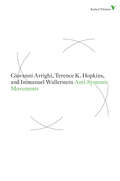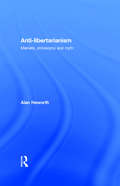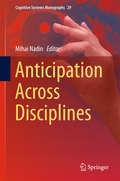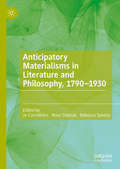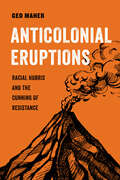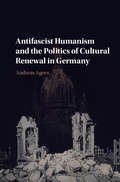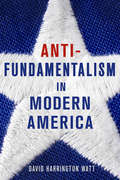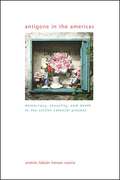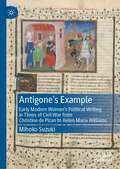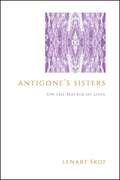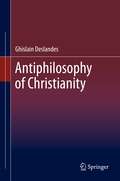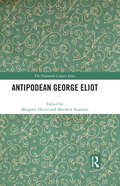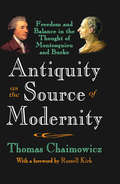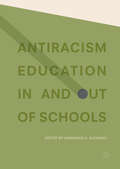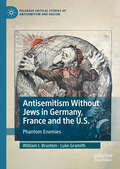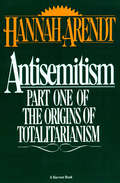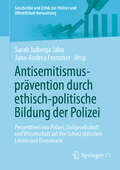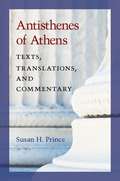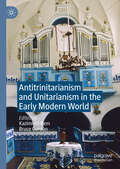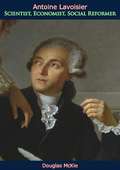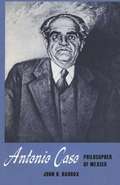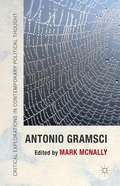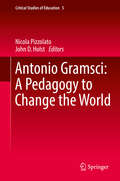- Table View
- List View
Anti-Systemic Movements
by Giovanni Arrighi Terence K. Hopkins Immanuel WallersteinBuilding on an analysis of the dissenting movements to have emerged since the rise of modern capitalism, Anti-Systemic Movements uncovers an international groundswell of resistance still vitally active at the end of the twentieth century. The authors suggest that the new assertiveness of the South, the development of class struggle in the East and the emergence of rainbow coalitions in various regions hold fresh promise for emancipatory politics. Taking the year 1968 as a symbolic turning point, the authors argue that new anti-systemic movements have arisen which challenge the logic of the capitalist world-system.
Anti-libertarianism: Markets, philosophy and myth
by Alan HaworthFree marketeers claim that theirs is the only economic mechanism which respects and furthers human freedom. Socialism, they say, has been thoroughly discredited. Most libertarians treat the state in anything other than its minimal, 'nightwatchman' form as a repressive embodiment of evil. Some reject the state altogether.But is the 'free market idea' a rationally defensible belief? Or do its proponents fail to examine the philosophical roots of their so-called freedom? Anti-libertarianism takes a sceptical look at the conceptual tenets of free market politics. Alan Haworth argues that libertarianism is little more than an unfounded, quasi-religious statement of faith: a market romance. Moreover, libertarianism is exposed as profoundly antithetical to the very freedom which it purports to advance.This controversial book is for anyone interested in the cultural and political impact of free market policies on the modern world. It will be invaluable to students and specialists of political and economic theory, social science and philosophy.
Anticipation Across Disciplines (Cognitive Systems Monographs #29)
by Mihai NadinNever before was anticipation more relevant to the life and activity of humankind than it is today. "It is no overstatement to suggest that humanity's future will be shaped by its capacity to anticipate. . . . " (Research Agenda for the 21st Century, National Science Foundation). The sciences and the humanities can no longer risk explaining away the complexity and interactivity that lie at the foundation of life and living. The perspective of the world that anticipation opens justifies the descriptor "the post-Cartesian Revolution. " If anticipation is a valid research domain, what practical relevance can we await? Indeed, anticipation is more than just the latest catch-word in marketing the apps developed by the digital technology industry. Due to spectacular advances in the study of the living, anticipation can claim a legitimate place in current investigations and applications in the sciences and the humanities. Biology, genetics, medicine, as well as politics and cognitive, behavioral, and social sciences, provide rich evidence of anticipatory processes at work. Readers seeking a foundation for an ticipation will find in these pages recent outcomes pertinent to plant life, political anticipation, cognitive science, architecture, computation. The authors contributing to this volume frame experimental data in language that can be shared among experts from all fields of endeavor. The major characteristic is the inference from the richness of data to principles and practical consequences.
Anticipatory Materialisms in Literature and Philosophy, 1790–1930
by Jo Carruthers Nour Dakkak Rebecca SpenceAnticipatory Materialisms explores nineteenth and early twentieth-century literature thatanticipates and pre-empts the recent philosophical ‘turn’ to materiality and affect. Critical volumes that approach literature via the prism of New Materialism are in the ascendence. This collection stakes a different claim: by engaging with neglected theories of materiality in literary and philosophical works that antedate the twenty-first century ‘turn’ to New Materialism and theories of affect, the project aims to establish a dialogue between recent theoretical considerations of people-world relations in literature and that which has gone before. This project seeks to demonstrate the particular and meaningful ways in which interactions between people and the physical world were being considered in literature between the nineteenth and early twentieth centuries. The project does not propose an air of finality; indeed, it is our hope that offering provocative and challenging chapters, which approach the subject from various critical and thematic perspectives, the collection will establish a broader dialogue regarding the ways in philosophy and literature have intersected and informed each other over the course of the long nineteenth century.
Anticolonial Eruptions: Racial Hubris and the Cunning of Resistance (American Studies Now: Critical Histories of the Present #15)
by Geo MaherThis incisive study reveals the fundamental, paradoxical weakness of colonialism and the enduring power of anticolonial resistance. Resistance is everywhere, but everywhere a surprise, especially when the agents of struggle are the colonized, the enslaved, the wretched of the earth. Anticolonial revolts and slave rebellions have often been described by those in power as "eruptions"—volcanic shocks to a system that does not, cannot, see them coming. In Anticolonial Eruptions, Geo Maher diagnoses a paradoxical weakness built right into the foundations of white supremacist power, a colonial blind spot that grows as domination seems more complete. Anticolonial Eruptions argues that the colonizer’s weakness is rooted in dehumanization. When the oppressed and excluded rise up in explosive rebellion, with the very human demands for life and liberation, the powerful are ill-prepared. This colonial blind spot is, ironically, self-imposed: the more oppressive and expansive the colonial power, the lesser-than-human the colonized are believed to be, the greater the opportunity for resistance. Maher calls this paradox the cunning of decolonization, an unwitting reversal of the balance of power between the oppressor and the oppressed. Where colonial power asserts itself as unshakable, total, and perpetual, a blind spot provides strategic cover for revolutionary possibility; where race or gender make the colonized invisible, they organize, unseen. Anticolonial Eruptions shows that this fundamental weakness of colonialism is not a bug, but a permanent feature of the system, providing grounds for optimism in a contemporary moment roiled by global struggles for liberation.
Antifascist Humanism and the Politics of Cultural Renewal in Germany
by Andreas AgocsAntifascism is usually described as either a political ideology of activists and intellectuals confronting the dictatorships of Hitler and Mussolini, or as a cynical tool that justified the Stalinist expansion of communism in Europe. Andreas Agocs widens our understanding of antifascism by placing it in the context of twentieth-century movements of 'cultural renewal'. He explores the concept of 'antifascist humanism', the attempt by communist and liberal intellectuals and artists to heal the divisions of Nazism by reviving the 'other Germany' of classical Weimar. This project took intellectual shape in German exile communities in Europe and Latin America during World War II and found its institutional embodiment in the Cultural League for Democratic Renewal in Soviet-occupied Berlin in 1945. During the emerging Cold War, antifascist humanism's uneasy blend of twentieth-century mass politics and cultural nationalism became the focal point of new divisions in occupied Germany and the early German Democratic Republic. This study traces German traditions of cultural renewal from their beginnings in antifascist activism to their failure in the emerging Cold War.
Antifundamentalism in Modern America
by David Harrington WattDavid Harrington Watt's Antifundamentalism in Modern America gives us a pathbreaking account of the role that the fear of fundamentalism has played—and continues to play—in American culture. Fundamentalism has never been a neutral category of analysis, and Watt scrutinizes the various political purposes that the concept has been made to serve. In 1920, the conservative Baptist writer Curtis Lee Laws coined the word "fundamentalists." Watt examines the antifundamentalist polemics of Harry Emerson Fosdick, Talcott Parsons, Stanley Kramer, and Richard Hofstadter, which convinced many Americans that religious fundamentalists were almost by definition backward, intolerant, and anti-intellectual and that fundamentalism was a dangerous form of religion that had no legitimate place in the modern world. For almost fifty years, the concept of fundamentalism was linked almost exclusively to Protestant Christians. The overthrow of the Shah of Iran and the establishment of an Islamic republic led to a more elastic understanding of the nature of fundamentalism. In the late 1970s and early 1980s, Americans became accustomed to using fundamentalism as a way of talking about Muslims, Jews, Hindus, Sikhs, and Buddhists, as well as Christians. Many Americans came to see Protestant fundamentalism as an expression of a larger phenomenon that was wreaking havoc all over the world. Antifundamentalism in Modern America is the first book to provide an overview of the way that the fear of fundamentalism has shaped U.S. culture, and it will lead readers to rethink their understanding of what fundamentalism is and what it does.
Antigone in the Americas: Democracy, Sexuality, and Death in the Settler Colonial Present (SUNY series in Gender Theory)
by Andrés Fabián Henao CastroSophocles's classical tragedy, Antigone, is continually reinvented, particularly in the Americas. Theater practitioners and political theorists alike revisit the story to hold states accountable for their democratic exclusions, as Antigone did in disobeying the edict of her uncle, Creon, for refusing to bury her brother, Polynices. Antigone in the Americas not only analyzes the theoretical reception of Antigone, when resituated in the Americas, but further introduces decolonial rumination as a new interpretive methodology through which to approach classical texts. Traveling between modern present and ancient past, Andrés Fabián Henao Castro focuses on metics (resident aliens) and slaves, rather than citizens, making the feminist politics of burial long associated with Antigone relevant for theorizing militant forms of mourning in the global south. Grounded in settler colonial critique, black and woman of color feminisms, and queer and trans of color critique, Antigone in the Americas offers a more radical interpretation of Antigone, one relevant to subjects situated under multiple and interlocking systems of oppression.
Antigone's Example: Early Modern Women's Political Writing in Times of Civil War from Christine de Pizan to Helen Maria Williams
by Mihoko SuzukiThis book investigates early modern women’s interventions in politics and the public sphere during times of civil war in England and France. Taking this transcultural and comparative perspective, and the period designation “early modern” expansively, Antigone’s Example identifies a canon of women’s civil-war writings; it elucidates their historical specificity as well as the transhistorical context of civil war, a context which, it argues, enabled women’s participation in political thought.
Antigone's Sisters: On the Matrix of Love (SUNY series in Theology and Continental Thought)
by Lenart ŠkofIn Antigone's Sisters, Lenart Škof explores the power of love in our world—stronger than violence and, ultimately, stronger even than death. Focusing on Antigone, Savitri, and Mary, the book offers an investigation into various goddesses and feminine figures from a variety of philosophical, mythological, theological, and literary contexts. The book also elaborates on the feminine aspects of selected concepts from modern philosophical texts, such as the Matrix in Jakob Böhme, Clara in F. W. J. Schelling, beyng in Martin Heidegger, chóra in Jacques Derrida, and breath in Luce Irigaray's thought. Drawing on Bracha M. Ettinger's concept of matrixiality, Škof proposes a new matrixial theory of philosophy, cosmology, and theology of love. Despite its many usages and appropriations, love remains a neglected topic within Western philosophy. With its new interpretation of Antigone and related readings of Irigaray, Kristeva, and Ettinger, Antigone's Sisters aims to identify some of the reasons for this forgetting of love, and to show that it is only love that can bring peace to our ethically disrupted world.
Antigone, Interrupted
by Bonnie HonigSophocles' Antigone is a touchstone in democratic, feminist and legal theory, and possibly the most commented upon play in the history of philosophy and political theory. Bonnie Honig's rereading of it therefore involves intervening in a host of literatures and unsettling many of their governing assumptions. Exploring the power of Antigone in a variety of political, cultural, and theoretical settings, Honig identifies the 'Antigone-effect' - which moves those who enlist Antigone for their politics from activism into lamentation. She argues that Antigone's own lamentations can be seen not just as signs of dissidence but rather as markers of a rival world view with its own sovereignty and vitality. Honig argues that the play does not offer simply a model for resistance politics or 'equal dignity in death', but a more positive politics of counter-sovereignty and solidarity which emphasizes equality in life.
Antiochus and Peripatetic Ethics (Cambridge Classical Studies)
by Georgia TsouniThis book offers a fresh analysis of the account of Peripatetic ethics in Cicero's On Ends 5, which goes back to the first-century BCE philosopher Antiochus of Ascalon. Georgia Tsouni challenges previous characterisations of Antiochus' philosophical project as 'eclectic' and shows how his reconstruction of the ethics of the 'Old Academy' demonstrates a careful attempt to update the ancient heritage, and predominantly the views of Aristotle and the Peripatos, in the light of contemporary Stoic-led debates. This results in both a hermeneutically complex and a philosophically exciting reading of the old tradition. A case in point is the way Antiochus grounds the 'Old Academic' conception of the happy life in natural appropriation (oikeiosis), thus offering a naturalistic version of Aristotelian ethics.
Antiphilosophy of Christianity
by Ghislain DeslandesThis text presents and addresses the philosophical movement of antiphilosophy working thru the texts of Christian thinkers such as Pascal and Kierkegaard. The author as influenced by Alain Badiou, portrays these Christian thinkers as of a subjective dimension negating the possibility of an objective quest for truth. The claim here is that antiphilosophy is abundant in the eyes of these two thinkers who frame the thought event as represented by Christianity, ultimately resigning itself to more or less the opposite of philosophy itself. Readers will discover why philosophical reason should never be convinced by that which denies its very authority.Subjecting faith to the perils of philosophical analysis, confronting the philosophical tradition with the truth of the Christian faith, and occupying the space between the two: such are the challenges facing an antiphilosophy of Christianity. This text will appeal to researchers and students working in continental philosophy, philosophy of religion and those in religious studies who want to investigate the links between Christianity and antiphilosophy.
Antipodean George Eliot (The Nineteenth Century Series)
by Margaret Harris Matthew SussmanIn Middlemarch, George Eliot famously warns readers not to see themselves as the centre of their own world, which produces a ‘flattering illusion of concentric arrangement’. The scholarly contributors to Antipodean George Eliot resist this form of centrism. Hailing from four continents and six countries, they consider Eliot from a variety of de-centred vantage points, exploring how the obscure and marginal in Eliot’s life and work sheds surprising light on the central and familiar. With essays that span the full range of Eliot’s career—from her early journalism, to her major novels, to eccentric late works such as Impressions of Theophrastus Such—Antipodean George Eliot is committed to challenging orthodoxies about Eliot’s development as a writer, overturning received ideas about her moral and political thought, and unveiling new contexts for appreciating her unparalleled significance in nineteenth-century letters.
Antiquity as the Source of Modernity: Freedom and Balance in the Thought of Montesquieu and Burke
by Thomas ChaimowiczThis is a book that contrary to common practice, shows the commonalities of ancient and modern theories of freedom, law, and rational actions. Studying the works of the ancients is necessary to understanding those that follow. Thomas Chaimowicz challenges current trends in research on antiquity in his examination of Montesquieu's and Burk's path of inquiry. He focuses on ideas of balance and freedom. Montesquieu and Burke believe that freedom and balance are closely connected, for without balance within a state there can be no freedom.When Montesquieu speaks of republics, he means those of antiquity as they were understood in the eighteenth century. In this view, freedom can develop only within the framework of established tradition. Edmund Burke's greatest service to political thought may lie in making use of this idea when he fought against the abstractions of the French Revolutionaries. Antiquity as the Source of Modernity examines Montesquieu's Roman mind, meaning not an attitude influenced by the ancients, but one primarily influenced by Roman heritage. It speaks to the antithesis of monarchy and despotism in Montesquieu's thought and the influence of Tacitus and Pliny the Younger on him. The separation of powers and its relation to the concept of the mixed constitution as well as Montesquieu's smaller masterpiece Considerations on the Causes of the Grandeur and Decadence of the Romans are examined in detail. Finally, the discussion leads seamlessly to Burke, who, as a critical admirer of Montesquieu, partly incorporated his interpretation of the English constitution into his own thinking threatened by teachings of the French Revolution and its British adherents.The central idea of Antiquity as the Source of Modernity is timeless. It is that the ancient past can lead to a clearer understanding of what follows. This perspective represents a reversal of the conventional procedures for conducting this kind of research,
Antiracism Education In and Out of Schools
by Aminkeng A. AlemanjiThis book explores how antiracism theories can be translated into practice within formal education, as well as in other educational programs outside schools, as very often racism occurs outside the school environment. Combating racism both in and out of school therefore increases the chances of overcoming issues of racism. As racism continues to plague the world, efforts to combat it deserve more attention and diversification across all walks of life. In education, such efforts benefit from being modeled within the framework of antiracism education, rather than simpler multicultural and intercultural theorization and understanding which have proved popular. As such, this book critiques integration and multicultural programs, and instead highlights the advantages of grounding such programs within an antiracist framework. This book demonstrates why and how antiracism education is key to challenging issues of racial injustice at a time when multiculturalism and interculturalism have being proclaimed "dead". It will be highly relevant to researchers and students working in the areas of Education and Sociology, particularly those with an interest in antiracism methodologies.
Antisemitism Without Jews in Germany, France and the U.S.: Phantom Enemies (Palgrave Critical Studies of Antisemitism and Racism)
by William I. Brustein Luke GramithWhy does antisemitic messaging strike a chord in certain communities without Jews but fall flat in neighboring communities equally without Jews? This book focuses on antipathy towards Jews - expressed through successful electoral campaigns where a candidate or political party championed antisemitism - in communities located in three different nations where the Jewish population had virtually no history of interaction with the resident majority population of non-Jews. The cases are: the election of antisemitic deputies in the 1893 German Reichstag Elections from eastern Saxony; the election of a slate of antisemitic deputies to the French Chamber in 1898 from the southwestern French department of the Gers; and the significant proportion of votes for the antisemitic campaign of Gerald B. Winrod in the U.S. Senate Republican Party primary election in 1938 in Kansas. Each of these examples illustrates the existence of heightened levels of antisemitism in cases where few, if any, Jews had engagement with the majority population.
Antisemitism: Part One of The Origins of Totalitarianism (The Origins of Totalitarianism #1)
by Hannah ArendtIn the first volume of her landmark philosophical work, The Origins of Totalitarianism, the political theorist traces the rise of antisemitism in Europe. Since it was first published in 1951, The Origins of Totalitarianism has been recognized as the definitive philosophical account of the totalitarian mindset. A probing analysis of Nazism, Stalinism, and the &“banality of evil&”, it remains one of the most referenced works in studies and discussions of totalitarian movements around the world.In this first volume, Antisemitism, Dr. Hannah Arendt traces the rise of antisemitism to Central and Western European Jewish history during the 19th century. With the appearance of the first political activity by antisemitic parties in the 1870s and 1880s, Arendt states, the machinery that led to the horrors of the Holocaust was set in motion. The Dreyfus Affair, in Arendt&’s view, was &“a kind of dress rehearsal&”—the first modern use of antisemitism as an instrument of public policy and of hysteria as a political weapon.&“The most original and profound—therefore the most valuable—political theorist of our times.&”—Dwight MacDonald, The New Leader
Antisemitismusprävention durch ethisch-politische Bildung der Polizei: Perspektiven von Polizei, Zivilgesellschaft und Wissenschaft auf den Schutz jüdischen Lebens und Demokratie (Geschichte und Ethik der Polizei und öffentlichen Verwaltung)
by Sarah Jadwiga Jahn Jana-Andrea FrommerZiel des Sammelbandes ist die Sensibilisierung für eine ethisch-politische Bildung in der Polizei über Antisemitismus unter Einbeziehung der Perspektiven von Polizei, Zivilgesellschaft und Wissenschaft auf den Schutz jüdischen Lebens und Demokratie. Hierfür werden praxisorientierte Möglichkeiten der Vermittlung aufgezeigt und Herausforderungen benannt. Vor allem geht es um die Frage, wie eine nachhaltige Vermittlungsarbeit aussehen kann, die gezielt eine Auseinandersetzung mit ethischen Fragen und lebensweltlichen Perspektiven Lehrender und Lernender einbezieht. Ausgangspunkt hierfür ist die Ambiguitätstoleranz als notwendige zentrale Fähigkeit der Lehrperson, Grundlage der Konzeption und Vermittlung in der Bildungsarbeit sowie als Kompetenzziel in der polizeilichen Bildung. Eine Möglichkeit zur Förderung dieser Kompetenz sowie zur Ausbildung der Fähigkeit demokratisch ausgerichteter Urteils- und Entscheidungsfindung besteht im Aufbau eines professionellen Verständnisses von Empathie.
Antisthenes Of Athens: Texts, Translations, And Commentary
by Susan PrinceAntisthenes of Athens (c. 445-365 BCE) was a famous ancient disciple of Socrates, senior to Plato by fifteen years and inspirational to Xenophon. He is relevant to two of the greatest turning points in ancient intellectual history, from pre-Socraticism to Socraticism, and from classical Athens to the Hellenistic period. A better understanding of Antisthenes leads to a better understanding of the intellectual culture of Athens that shaped Plato and laid the foundations for Hellenistic philosophy and literature as well. Antisthenes wrote prolifically, but little of this text remains today. Susan Prince has collected all the surviving passages that pertain most closely to Antisthenes' ancient reputation and literary production, translates them into English for the first time, and sets out the parameters for their interpretation, with close attention to the role Antisthenes likely played in the literary agenda of each ancient author who cited him. This is the first translation of Antisthenes' remains into English. Chapters present the ancient source, the original Greek passage, and necessary critical apparatus. The author then adds the modern English translation and notes on the context of the preservation, the significance of the testimonium, and on the Greek. Several new readings are proposed. Antisthenes of Athens will be of interest to anyone seeking to understand Antisthenes and his intellectual context, as well as his contributions to ancient literary criticism, views on discourse, and ethics.
Antitrinitarianism and Unitarianism in the Early Modern World
by Bruce Gordon Kazimierz BemThis collection offers an innovative and fresh interpretation of Antitrinitarian and rational dissent in the early modern world. The central themes focus on the fierce debates surrounding Antitrinitarianism and Unitarianism that emerged from the Reformation and the lived cultures of these dissenting movements. The chapters take an interdisciplinary approach addressing ideas in context, their reception and appropriation, and the diverse and often conflicting visions of Christianity. Drawing on previously unused sources, many from Eastern Europe and often in inaccessible languages, this book challenges our understanding of dissent as marginal and eccentric and places it at the center of contesting convictions about the nature of religious reform.
Antoine Lavoisier: Scientist, Economist, Social Reformer (Series In Science)
by Douglas McKieANTOINE LAURENT LAVOISIER is heralded as the founder of modern chemistry whose genius was cut short by the brutal Revolutionary terror of the French Revolution. "Only a moment to chop off that head," said Lagrange the mathematician to Delambre, one of the inventors of the metric system, "and a hundred years may not give us another like it."Until Antoine Lavoisier, all matter was believed to be composed of four elements: earth, water, air and fire. It was Lavoisier who first showed that Nature was made out of much more complicated stuff, and that bodies burn not by releasing their fire element, but by combining with the element oxygen, the same element that enables plants and animals to breathe.
Antonio Caso: Philosopher of Mexico
by John H. HaddoxFew men have had as much cultural and educational influence on their own countries as the philosopher and educator Antonio Caso (1883-1946). He was above all a patriot of his beloved Mexico, and he sought to deliver his humanitarian message to his countrymen. In his youth, after the revolt against Díaz, he was a member of the Ateneo de la Juventud, a group that sought to bring Mexico, spiritually and economically, back to the Mexicans. Caso realized that this effort involved the forming of a national consciousness among his people, whom he saw divided by their private and public interests. As an educator of Mexican youth for more than thirty years, Caso sought to imbue in his students the desire to search and to question. He saw education as a perpetual search for truth, and his own life and philosophy reflect this search. He rejected any system that proposed to describe all of reality, and he despised all dogmas-official or unofficial. He particularly fought against positivism and Marxism, systems current in his youth. The first part of this book is an introduction to the philosophical and educational ideas of Caso, as well as to the intellectual and political ideas in his life. Mr. Haddox skillfully shows the development of Caso's ideas and how they took shape from his own reading as well as from the experiences of his age and of his country. The second part contains Mr. Haddox's translations of selections from Caso's writings. They give a moving picture of Caso's hopes for Mexico and for humanitiy.
Antonio Gramsci (Critical Explorations In Contemporary Political Thought Ser.)
by Mark McNallyThe thought of Antonio Gramsci continues to enjoy widespread appeal in contemporary political and social theory. This book draws together some of the world's leading scholars on Gramsci to critically explore key ideas, debates and themes in his work in an accessible manner, relating them to contemporary politics and society.
Antonio Gramsci: A Pedagogy To Change The World (Critical Studies of Education #5)
by John D. Holst Nicola PizzolatoThis book is a collection of essays on the educational thought and the pedagogical approach of Italian thinker Antonio Gramsci. Preceded by a broad introduction that positions Gramsci in his context and in the literature, the essays critically revisit the many passages of the Prison Notebooks and pre-prison writings where Gramsci addresses the nexus between politics and pedagogy. Some essays apply those concepts to specific contexts. The book for the first time brings to the attention of an English-speaking audience voices from the current historiography in Italy and Latin America. Overall, the volume provides evidence for the argument of a central place of pedagogy in the interpretation of Gramsci's political theory. Gramsci's view that 'every relationship of hegemony is necessarily a pedagogical relationship' makes it imperative to dismiss narrow and formal interpretations of his educational theories as applying to schooling only. This book argues that what is required rather is an inquiry into the Italian thinker's broad conceptualisation of pedagogy, which he thought as a quintessential political activity, central to understanding and transforming society. Contributors: Stephen Brookfield, Alessandro Carlucci, Diego Fusaro, Flora Hillert, John D. Holst, Carl Levy, Pietro Maltese, Peter Mayo, Riccardo Pagano, Rebecca Tarlau, Andr#65533; Tosel, Mar#65533;a A. Vetter.
